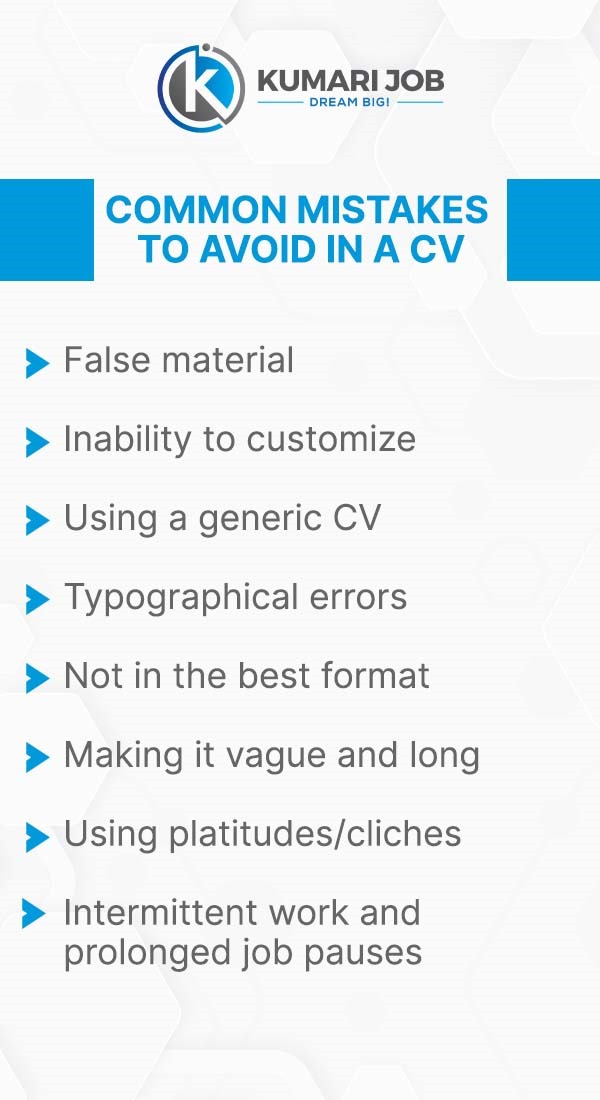What is a CV?
A CV is a written summary of a potential employee's career, qualifications, and education. It may include volunteer work, internships, and informal training. According to wikipedia: a curriculum vitae is a short written summary of a person's career, qualifications, and education.
A CV, or curriculum vitae, is a detailed, 1-2 page document that highlights your educational or career achievements and experiences. You’re going to be asked to provide a CV when applying for jobs in the EU, or if you’re applying in the academic field in the USA.
The most common format consists of the following sections, in the order listed:
- your work experience
- your non-work experience, including involvement in professional organizations and the community
- your education, certifications, and licenses
- any other skills and interests related to the job
Each section may include information in reverse chronological order. This means you list your experiences from the most recent to the least recent. For example, you might list your current or most recent job position first and then list each job you previously held.
What does a CV consist of?
There is no strict rule for that. It all depends on your experience and the position you are applying for. There are, however, some sections that are there to stay no matter what.
Every CV must include the following:
1. Contact Information
2. CV Summary or Objective
3. Work Experience
4. Education
5. Skills
Depending on your profile, you can also include the following sections:
1. Certificates and Awards
2. Volunteer Experience
3. Personal Projects
4. Languages
Differences between CV and Resume
A CV—short for the Latin “curriculum vitae,” meaning “course of life”—is a detailed document highlighting your professional and academic history. CVs typically include information such as your work experience, along with your achievements, awards, scholarships or grants you’ve earned, coursework, research projects and publications of your work.A CV is typically two or three pages long, but it’s not unusual for it to be much longer for mid-level or senior job applicants, as a CV serves as a full outline of one’s career accomplishments. When it comes to CVs, though, don't cut crucial information just to save space.
Whereas,
A resume is a formal document providing an overview of your professional background and relevant skills. Standard sections on a resume include your work history, education, a professional summary, and a list of your skills. The three resume formats are reverse chronological, functional and combined.
What to consider when writing a CV
A CV is often specific to the job and employer. It typically matches the job criteria. Researching the position and employer allows you to create a CV that attracts the employer's attention. Include keywords in the job advert to get past applicant tracking system programs that screen CVs before the employer reads them.
Almost all companies use these programs in the hiring process. You want to make sure an actual person reads your CV. Your research into the employer and position might also help you determine whether it's the right job for you. Once you've learned the requirements of the job, you can compare them to your own goals. If they align, then you can proceed with the CV and application process.
1. Keep it brief, no more than two pages.
2. Avoid superfluous personal details such as age, religion, and sex.
3. Don’t write in the first person - start sentences with verbs.
4. List your career history in reverse chronological order, explaining any gaps.
5. Bullet achievements and responsibilities, including more detail on recent roles.
6. List educational institutions and qualifications in reverse chronological order.
7. Include computer skills, language skills, and any relevant training.
8. Keep your hobbies and interests section short.
9. Referees can be provided on request.
10. Check for typos and ask a friend to read it through too.
How to Format Your CV
When it comes to layout, most choices come down to preference. How you want your CV to look and how you want the information to be organised.
When making these decisions, keep these tips in mind:
- Stick to one page. No recruiter has time to go over more than that. Unless you have a very extensive work history that needs additional space, one page should be enough.
- Keep it consistent. Use the same colors, the right font, and font size for every section and section header. You want your CV to have a clean, professional, and organized look. (So, no comic sans for you.)
- Get the spacing right. There should be enough space between lines and sections so that everything is distinctive and easy on the eyes. Be careful of the other extreme, however. Wide margins and too many spaces might leave your CV looking weird.
- Save it in the right format. Some companies might specifically ask you to send them a.docx file. If they don’t, we’d recommend saving your CV as a PDF. This will make sure the formatting remains intact and your CV has a higher chance of getting past applicant tracking systems.
Contact Information in a CV
You can’t really get a job if the recruiter can’t call you back to let you know the position is yours, right? It’s crucial that you enter your contact information correctly and provide the recruiter with at least two ways of reaching back to you.
The must-have information for your CV consists of:
- First name and Last name.
- Phone number
- Email address
- Professional title
- Location
- Relevant social media (Optional)
All information should be up-to-date and professional. This means no funny, confusing email address and no buzzwords in your job title.
CV Summary or Objective
On average, recruiters only spend about 7 seconds going over each CV before deciding to toss it or consider it further. How do you convince the recruiter you’re perfect for the job in just 7 seconds? Use a CV summary or objective.
If you’re a recent graduate or you’re changing careers, a CV objective is what you should be using. It’s 2-3 sentences that give the recruiter a glimpse of your skills, motivation in the field, and career goals. On the other hand, if you’re an experienced professional with years in the industry, you should be using a CV summary.
As the name suggests, a CV summary is a snapshot of your professional history that highlights your experience and achievements in the field.
Common Mistakes To Avoid In A CV
- Typographical errors and poor grammar.
- Putting more emphasis on responsibilities than successes.
- Using platitudes/cliches
- False material
- Not in the best format
- Inability to customize
- Intermittent work and prolonged job pauses
- Using a generic CV
- Making it vague and long.
- Typographical errors and poor grammar: This refers to spelling mistakes, grammatical inaccuracies, or punctuation errors in your CV. These issues might make you look indifferent or unworthy to potential employers. Therefore, you must edit and then proofread your CV, and if possible, ask someone else to look at it for you.
- Putting more emphasis on responsibilities than successes: Instead of merely listing your job duties, focus on your achievements and successes in each role. Employers are more interested in what you have accomplished than just what tasks you were assigned. Highlighting specific accomplishments demonstrates your value and capabilities.
- Using platitudes/cliches: Do not use an overused phrase or cliché that holds little information. Words or phrases such as “team player,” “hardworking,” or “detail-oriented” are meaningless as they do not provide examples to back up these claims. Therefore, use concrete things that happened or measurable achievements to prove your words.
- False material: Including false or exaggerated material or documentation on your CV could be disastrous when uncovered by the potential employee. It is always wise to tell the truth about your qualifications, job skills, and work experiences. Lying about a previous job, a degree, or skill or in your academic grades can destroy your relationship with the employer and your chances of getting that job
- Not in the best format: A well-organized, visually appealing CV should be easy to read and visually appealing, using clear headings, bullet points, and concise language. A professional font and consistent formatting style are essential, as a disorganized CV can hinder employers' navigation and detract from qualifications.
- Inability to customize: Customizing your CV for each job application is crucial to highlight relevant experiences and skills. Avoid generic CVs that don't meet the job's requirements. Research the company and role thoroughly, and tailor your CV to demonstrate your suitability for the position.
- Intermittent work and prolonged job pause: Employers may notice gaps in your employment history, so it's crucial to address these periods in your CV and highlight relevant experiences or skills. Consider volunteering, freelance projects, or professional development activities to fill in gaps and demonstrate your commitment to continuous learning and growth.
- Using a generic CV: To maximize your chances of success, it's essential to create a unique CV for each job application, avoiding a one-size-fits-all approach that may not accurately reflect your qualifications and experiences.
- Making it vague and long: A concise CV should focus on relevant information, avoid unnecessary details, and be specific in describing your experiences, skills, and accomplishments. Use concise language to effectively convey your qualifications, as a long and vague CV can be overwhelming for employers and overlook key information about your suitability for the role.
Frequently Asked Questions
Spelling, punctuation and grammatical errors
Always double-check the spelling on your CV. Ensure you are writing in the correct tense and if you are using the third person, stick to it throughout the document. Avoid Americanisms and use the spell-check.
A resume with proper grammar and spelling demonstrates your professionalism, attention to detail, and communication skills, all of which are highly sought after by employers. By meticulously proofreading your resume, you present yourself as a competent and reliable candidate right from the start.
What's the ideal CV length? 91% of recruiters we surveyed called two pages the perfect CV length. Obviously, this might vary depending on your experience. If you're just graduating, for example, chances are you won't have as much to say as someone who's been working in an industry for 30 years.
Now, let's do a quick recap of the most important things we've mentioned in this article. In your CV, make sure to include: The essentials. This includes contact information, resume summary or objective, work experience, education, and skills.
Conclusion
Crafting an effective CV requires careful attention to detail and a strategic approach. Understanding the essential components of a CV, such as contact information, a summary, work experience, education, and skills, can help highlight qualifications and experiences effectively. However, common mistakes like typos, grammatical errors, poor formatting, and focusing solely on responsibilities can diminish the impact of your CV. Tailoring your CV to each job application, emphasizing relevant experiences and skills, and addressing any gaps in employment history thoughtfully can enhance your chances of success in the competitive job market.




